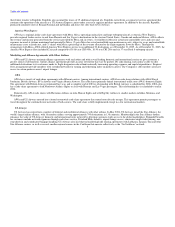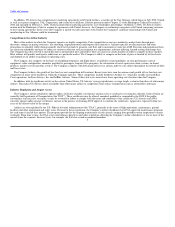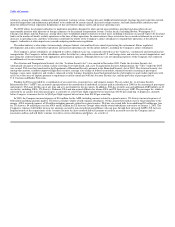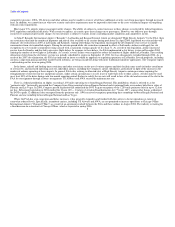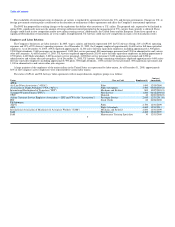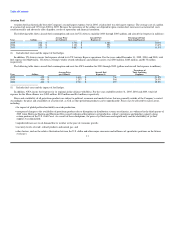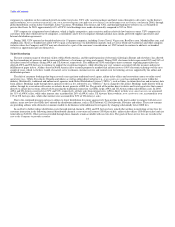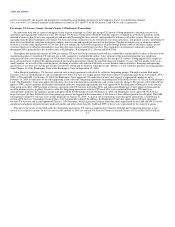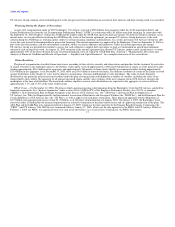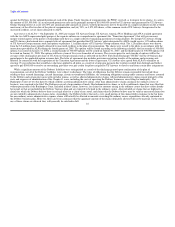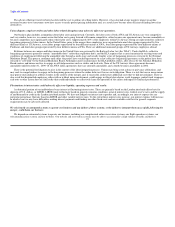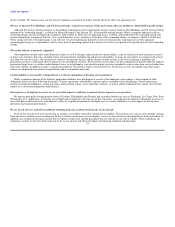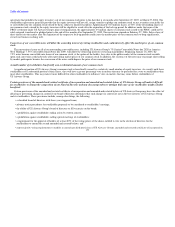US Airways 2005 Annual Report Download - page 21
Download and view the complete annual report
Please find page 21 of the 2005 US Airways annual report below. You can navigate through the pages in the report by either clicking on the pages listed below, or by using the keyword search tool below to find specific information within the annual report.
Table of Contents
service as required by the traveler and promote the continued goal of shifting customers to the Company's lowest cost distribution channel,
www.usairways.com. Internal channels of distribution account for 25% and 47% of all US Airways' and AWA's sales, respectively.
Pre-merger US Airways Group's Second Chapter 11 Bankruptcy Proceedings
In connection with and as a part of emergence from its prior bankruptcy in 2003, pre-merger US Airways Group undertook a thorough review of its
operations and significantly reduced its costs. Pre-merger US Airways Group also reduced its mainline capacity, realigned its network to maximize yield,
initiated a business plan to use more regional jets and procured financing for these aircraft, and expanded its alliances with other carriers. However, after
emerging from the prior bankruptcy, pre-merger US Airways Group continued to incur substantial losses from operations. The primary factors contributing to
these losses included the reduction in domestic industry unit revenue and significant increases in fuel prices. The downward pressure on domestic industry
revenue is a result of the rapid growth of low-fare, low-cost airlines, the increased transparency of fares through Internet sources and other changes in fare
structures that have resulted in substantially lower fares for many business and leisure travelers. The competitive environment continued to intensify
throughout 2004, particularly in key markets such as Philadelphia, Washington, D.C., Boston and New York.
Throughout the spring and summer of 2004, pre-merger US Airways Group communicated with key stakeholders and the public its plan, referred to as the
transformation plan, to transform US Airways into a fully competitive and profitable airline. A key element of the transformation plan was significant
reductions in labor costs through changes to US Airways Group's collective bargaining agreements. Pre-merger US Airways Group aggressively sought the
necessary agreements to allow full implementation of the transformation plan without the need for filing new Chapter 11 cases, but was unable to do so in a
timely manner. As a result of the recurring losses, declining available cash and risk of defaults or cross defaults under certain key financing and operating
agreements, it was necessary for the pre-merger US Airways Group and its domestic subsidiaries (the "Debtors") to file voluntary petitions for reorganization
under Chapter 11 of the Bankruptcy Code in the Bankruptcy Court on September 12, 2004.
After filing for bankruptcy, US Airways achieved cost-savings agreements with all of its collective bargaining groups. Through a motion filed under
Section 1113(e) of the Bankruptcy Code on September 24, 2004, US Airways sought interim relief from collective bargaining agreements with ALPA, AFA,
TWU, CWA and IAM. On October 15, 2004, the Bankruptcy Court approved 21% reductions to base rates of pay for represented employees until
February 15, 2005 or until entry of an order approving a new collective bargaining agreement or granting final relief under Section 1113(c) of the Bankruptcy
Code. The Bankruptcy Court also approved reductions to certain retirement plan contributions and certain work rule changes. The interim relief order did not
apply to TWU, whose members had reached and ratified collective bargaining agreements that were approved by the Bankruptcy Court prior to the interim
relief going into effect. ALPA ratified a tentative agreement with US Airways in October 2004, and subsequent Bankruptcy Court approval eliminated the
need for interim relief as to pilots. Tentative collective bargaining agreements with the CWA and AFA were reached in December 2004 and were
subsequently ratified by the employee groups and approved by the Bankruptcy Court. On January 6, 2005, the Bankruptcy Court approved US Airways'
request to reject all three IAM collective bargaining agreements and approved the termination of US Airways' three defined pension benefit plans. The IAM
subsequently ratified US Airways' cost-savings proposals on January 21, 2005. As part of these negotiations and subsequent ratifications, contributions to
certain of US Airways' remaining retirement plans were permanently reduced. In addition, the Bankruptcy Court also approved a settlement agreement
between US Airways and a court-appointed Section 1114 Committee, which represented retirees other than those represented by the IAM and TWU, for the
significant curtailment of postretirement medical benefits and other retiree benefits. IAM and TWU retirees were represented by the respective unions.
Pursuant to the newly restructured collective bargaining agreements, US Airways implemented voluntary furlough and termination programs across
several of its employee groups. In the first and second quarters of 2005, pre-merger US Airways Group recognized charges of $51 million and $4 million,
15


